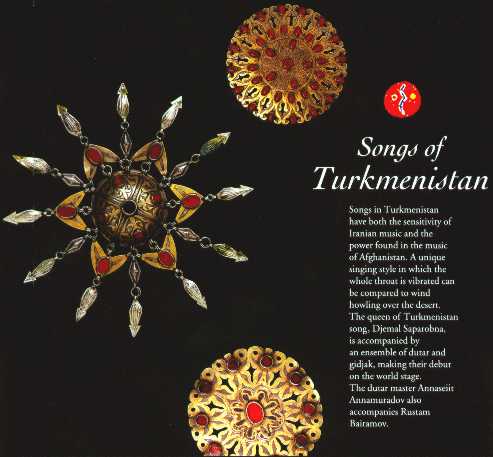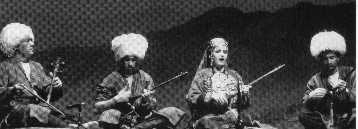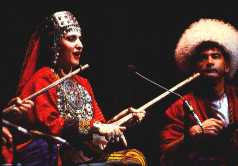|
Songs of Turkmenistan
COPYRIGHT
İ™LEMI›AR

The vocal pieces are
sung by a performer who both sings and plays the dutur,
but quite often the another dutur player aud a gidzhak player are added
to make a trio. This CD features the female singer Djamar
and male singer Rusturn - for the first half and
second half of the disc respectively - and two groups who play in ensemble
with them.
The vocal use of the throat
is quite unusual and the characteristic is in its staccato- ornamentation -
it sounds as if the singers hold their breath for very short intervals.
Many songs started off in melismatic style with prolonged high notes. Irregular and
free rhythms are also characteristic.
The musical instruments
used here are common throughout Central and Western Asia,
but no drums are used here.
The dutur
is the most popular instrument in Turkmenistan. It has a small,
pear-shaped body and a long neck. Two steel strings (they used to be made of
silk) are plucked by the fingers. The strings are tuned a fourth apart - for
example re/so/do - and the parallel fourths have their own characteristic
timbre. Also, one of the strings is often used as a drone. In Persian, du
means "two" and tar means "string." This type of long
necked lute can be found all over Central Asia.
The gidzhak
is a 3-or-l-stringed bowed instrument also tuned in fourths. The neck has no
frets and it is held in a horizontal position. On this CD, the inellow and rich timbre of the gidzhak
follows the melody made by the dutur. The same kind
of instruments are used in Iran
and Azerbaijan
too.
At the present time, new
music featuring synthesizers with mechanically set rhythms is gaining in
popularity and an electric dutur has even made its
appearance, but as much as possible this music follows the rules of
traditional music.
This is a recording of
musicians who came to Japan
for a concert entitled "A
Musical Voyage Along The
Silk Roa, V111 -1,.'pic Ballads from Afar," which was held in March and
April of 1993, and this CD can be called a sequel to "Instruniental Music Of Turkmenistan- which has already
been released in the World Music Library series.
*ON THE TRACKS
1) DJANYMYN-DJANANASY
A love Song by Turkmenistan
classic poet Zelili.
2) IZLAMA
A Turkmenistan
folk song based on epic called "Leili ve (and)
Mejnun." This epic is a tragic love story akin
to Romeo and Juliet. (Mejnun means a hinatic.) Since olden times, the art of story-telling
flourished in Central and Western Asia and
similar stories can be found in those areas. "Leili
ve Mejnun" is the one of those stories and was
originally based on an Arabian legend.
3) GASHLI YAR
This is a song of love.
4) ZULPUN SENIN
A love song by Gul Baba, a Turkmenistan
poet.
5) KHAIT IYKAN
A love song by Kemine (1770-1840), a poet in Turkmenistan.
6) OBADAN GELIN
(Beautiful Bride)
7) ZARY BILEN
A traditional love song.
8) BIVEPARARDAN
(Betrayal)
A song of warning to the Turkmenistan
people based on a poem by Maxtumkuli Fragi (1730-1782). In the eighteen century, Turkmenistan
poetry developed greatly, as did the music, and Maxtumkuli
is a poet who is sometimes called "the father of modern Turkmenistan literature."
9) CHARDI CITDI (Come
and Gone)
Another song by Maxtumkuli, giving a lesson of life. "Everybody is
born and, sooner or later, will die."
10) AK YUZLI MARALYM
(You Are My Beautiful One)
A love song made by DUrdy,a baxshi
who was active at the turn of the twentieth century.
11) SHIRMAIY DORAK
(Ivory Comb)
12) AMAN AMAN
A folk song based on an
epic called "Shasenern ve Garip."
"Aman Aman" is
an interjection.
13)YATAN
BORIP (You Can't Live Without Money)
Another lesson-of-life song
by Maxtumkuli.

PERFORMERS

Djemal Saparova (vocals and dutar)
After learning at Gahla
Sentriev Music School
in Ashkhabad,
the capital, she graduated from M. 1. Kalinin University
then joined the Ashkhabad Ensemble. She also established Djemal
Saparova Studio and has been working with her own
group. She has played concerts in European and Asian countries.
Allaverdi Ataev (gidjak)
He once belonged to the
Folk Music E.nsemble studio (1979-1981), then
played as a member of the Folk Instruments Ensemble of the Turkmen Republic
from 1983 to 1986. After that, he joined Djemal Saparova Musical Ensemble. He has also played concerts in
Western Asian countries.
Rustam Bairamov (vocals, dutar)
He used be a member of the Turkmenistan Science Academy
and is no", a member of Djemal Saparova Musical Ensemble.
Annaseijt Annamuradov (dutar)
After graduating from the National Music School
in Obezov in 1981, he became a dutar
teacher at the school. At the same time, he has played actively as soloist.
His father is a famous dutar player as well.
Written by:Uramoto
Yuko
(translated by Mogi
Takeshi)
|
Founded
And Designed By:
Dr. Farzad MARJANI, Civil Engineer, Ph.D.
Ankara
- TURKEY
|
|
|


